Asters, a handy guide to recent name changes
Asteraceae as a family is one of the largest families of plants containing 1600 genera and within that approximately 25000 species.
Asters or the Michaelmas daisies were a group of about 500 species. In order to make understanding and identifying these plants easier, taxonomists have begun to separate the genus Aster into separate groups that are more closely related.
Here we introduce you to some of the more popular plants and explain why and how they were split into separate groups. I promise it is not as dry as it sounds.
Plants in the Aster family can be identified by their open yellow centred flowers (until pollinated, then they mature to a rusty red) surrounded by many small brightly coloured petals in a range of colours, white, pink, red, blue and purple. This is known as a ray floret and strongly resembles a child’s drawing of the sun.
Asters from Southern Europe such as Aster amellus (Italian Aster) and its closest relatives have kept the name Aster. Others in this group are Aster thomsonii, Aster x fricartii, Aster pyrenaeus and Aster peduncularis.
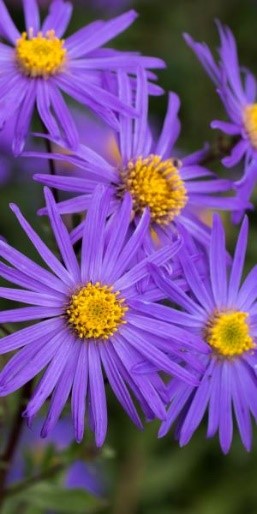 Aster amellus 'King George'
Aster amellus 'King George'  Aster peduncularis
Aster peduncularis
Aster tripolium or sea Aster which is native to the UK has a genus all of its own and is now called Tripoleum pannonicum. This has succulent leaves and is a biennial, native to salt marshes and is very useful in coastal gardens. It grows very well on my sandy soil near Romsey.
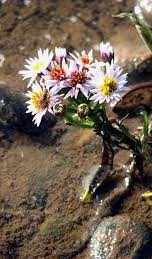 Tripoleum pannonicum
Tripoleum pannonicum
Aster sedifolius has become part of the European genus Galatella with another 40-50 species.
Galatella are herbaceous perennials from Europe and Asia and number approximately 50 species. Growing to between 50 and 100 cm with dense foliage. The flowers are shades of lavender to purple and its near relative the Galatella linosyris (linoseris) sometimes called the Goldilocks Aster, has rayless yellow flowers.
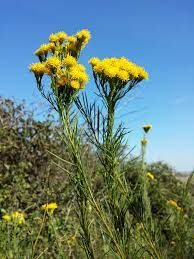 Galatella linosyris
Galatella linosyris
Plants that originated in the Northern USA and make up the largest group, have been split off into different genera including, Doellingeria, Eurybia and Symphyotrichum (which contains the majority of the so called, Michaelmas daisies). There are other genera in this group but these are the largest.
Doellingeria, this is a genus of three species all from eastern USA and are hardy, herbaceous perennials. Of these, only one cultivated species exists under the name of Doellingera unmbellata and can reach 2 meters tall and has flat topped clusters of white petalled ray florets.
Eurybia is a genus of 23 species that originated in the USA and northern Europe. These are rhizomatous perennials that grow up to 1.2 m tall. The flower heads are ray florets in colours from white to purple around a yellow disk that matures to purple.
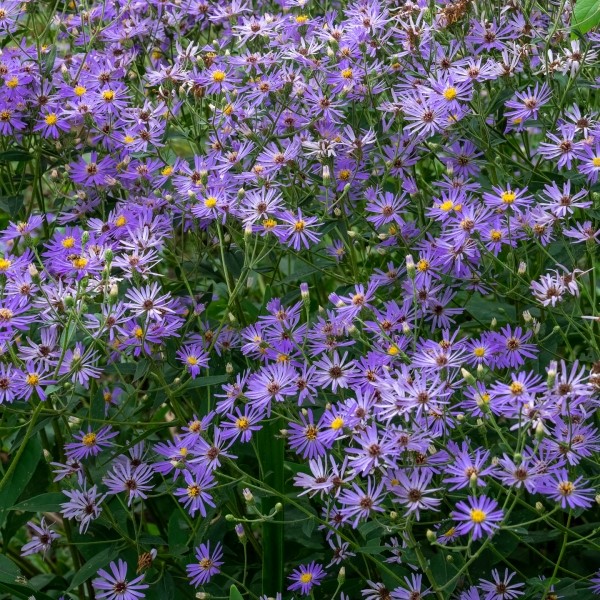 Eurybia x herveyi
Eurybia x herveyi  Eurybia divarica
Eurybia divarica
Finally, we come to the largest group, Symphyotrichum. This genus has approximately 90 species which are native to the USA and one that is native to Eurasia, Symphyotrichum cilatum. This group contains all the Michaelmas daisies, Symphyotrichum novi-belgii and Symphyotrichum novi-angliae. It also contains the smaller flowered types such as Symphyotrichum ericoides and Symphyotrichum laterifolius.
 Symphyotrichum ‘Little Carlow’ (laterifolius hybrid))
Symphyotrichum ‘Little Carlow’ (laterifolius hybrid)) 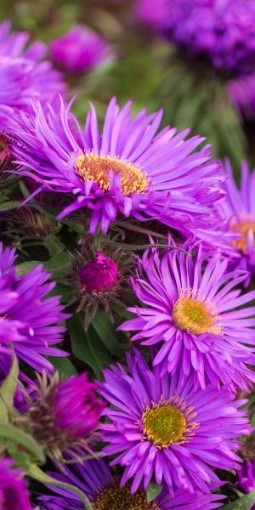 Symphyotrichum novi-belgii 'Purple Dome'
Symphyotrichum novi-belgii 'Purple Dome'
The foliage of these plants can change significantly throughout the growing season and the arrangement and shape of the flower heads can be changed by environmental factors which can make identification difficult.
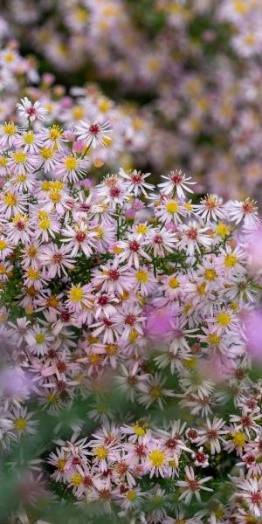 Symphyotrichum ericoides ‘Pink Cloud’
Symphyotrichum ericoides ‘Pink Cloud’
Asters and their kin are a star of the late Summer/ Autumn garden and thrive in a sunny to part shade spot, on slightly damp, fertile soil. They will tolerate more heat, but not if the ground is very free draining. Bees are drawn to the profusion of open flowers that bloom in succession.
